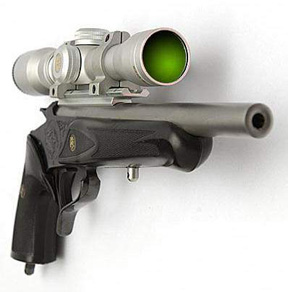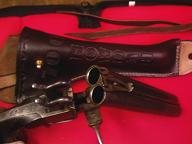

 The Accurate Reloading Forums
The Accurate Reloading Forums  THE ACCURATE RELOADING.COM FORUMS
THE ACCURATE RELOADING.COM FORUMS  Hunting
Hunting  Handgun Hunting
Handgun Hunting  90,000 - 100,000 PSI
90,000 - 100,000 PSIGo  | New  | Find  | Notify  | Tools  | Reply  |  |
| one of us |
In the Shooting Times Magazine in the article on the .500 S&W Mag. it said that the normal cartridge is creating about 90,000 psi and they are loading them over 100,000 psi and all its doing is spliting the cartridge at 100,000. How is this gun so STRONG. So in that case a bolt action rifle couldnt even handle this round. If anyone can enlighten me it would be great, this is blowing my mind?!?!?!?! [ 04-11-2003, 22:38: Message edited by: TrapShooter ] | ||
|
| one of us |
TrapShooter, David Clements sent me an email about his fear to build me a .500 S&W from a .357 Ruger max. Thre pressure is a little bit over 50000 psi. The cylinder must be huge and strong. It isn't possible to do this in SA revolver with a .357 Ruger Max frame. I have choosen the .475 Long aver the .500 S&W for this reason. The .500 Long works at a lower pressure than .500 S&W. | |||
|
| one of us |
I will have to reread the article. I thought it was they were using proof rounds to try to blow the gun up at 100,000 Hcliff | |||
|
| one of us |
Hcliff, That is what they are doing, but still they said it didnt hurt the gun that much. This just amazes me ! | |||
|
| one of us |
Let try to break it. It does have strength. I think John Linebaugh couldn't hurt the Ruger frame if I remember Ross Seyfries articles a few years ago. Blew up cylinder etc. When I compared the full size pic and put my SRH over the 500 it was bigger but not by as much as I was lead to believe. IT was said in the new pedersen's Hunting Mag that with the break the 500 felt like a Taurus 454. Hcliff | |||
|
one of us |
On the Smith and wesson forum, the project design engineer was answering questions awhile back about the new gun and cartrige. He say's the gun is rated for everyday loads up to 60Kpsi, but the Corbon Ammo will only be loaded up to 40kpsi. The posted velocities are at the 40kpsi range. I'm sure that if the Ruger Maximum will handle a 475 long, then it should be able to handle the 500S&W. | |||
|
| one of us |
Lar45, On the Smith and wesson forum, the project design engineer was answering questions awhile back about the new gun and cartrige. He say's the gun is rated for everyday loads up to 60Kpsi, but the Corbon Ammo will only be loaded up to 40kpsi. The posted velocities are at the 40kpsi range. I'm sure that if the Ruger Maximum will handle a 475 long, then it should be able to handle the 500S&W.[/QUOTE] combination of cyl thickness, type of metal, size of the cartridge and working pressure are the main things to not to build a gun in this caliber. I know that Gary Reeder and Mag. Reas. will chamber this cartridge in their SA gun. I really don't need this cartridge as John is building me a .500 Long and Dave will build me a .475 Long. I follow Dave's advices , he knows what he says. He is one of the five great and best customizers for Ruger in the US. I prefer a guy who warns me about his fear about a gun in .500 S&W before he made it. Than a guy who will build me this gun without warnings, and after some shots I'll have big problems. When we talk about a cost over $2500, I prefer to be sure to never blow up the gun in following reload datas. just my 0.02 cts | |||
|
| one of us |
Isn't Gary Reeder doing .500 S&Ws on his stretch-frames? I see no reason why a Blackhawk equivalent couldn't handle the S&W round. I've converted numerous Rugers to .454 Casull and shot 60,000 cup loads all day. If the cylinder is fit correctly with tight chambers, these guns will take a pounding. My personal Casull-converted Blackhawk has over 3,000 rounds of heavy .454s and the gun is as tight as the day it was built. Lee Martin www.singleactions.com | |||
|
| new member |
Ruger steel can take those pressures, below is a article explaining. Big guns need strong steel By Joseph Ogando, Materials and Fastening Editor Gunmaker zeroes in on aerospace alloys to toughen its latest product Newport, NH-Anyone who decides to shoot a bear with a handgun has two overwhelming concerns. Not missing is really, really important. And so is having a gun with some stopping power since angry bears are unlikely to be gracious about a flesh wound. The Super Redhawk .454 from Sturm Ruger has nothing if not stopping power. One of the most powerful six-shooters in the world, this revolver shoots a .454 Casull cartridge that packs about 50% more power than a 44 magnum. It's a cartridge that straddles a fine line between bullet and bomb. For the shooter, all this extra muscle translates to a gun that, in the right hands, can drop a bear, elk or other large animal at a distance up to 200 yards. For the engineers who worked on the Super Redhawk, the added power forced them to expand their arsenal of gun steels. Ruger Chief Engineer Steven Perniciaro points out that the .454 Casull goes off with the highest chamber pressures (62,000 psi) of any handgun on the market. Those pressures-and the resulting stresses-triggered a tightening of strength and fracture-toughness requirements that ruled out the 410 stainless that Ruger successfully uses for smaller guns. "Type 410 stainless just wasn't as strong as we would have liked," Perniciaro says. Looking for a material that could stand up to the .454, Ruger's engineers decided to give specialty alloys a shot. They constructed the Super Redhawk's cylinder and barrel from alloys that Carpenter Technology Corp. (Reading, PA) first developed for aerospace applications. Six-shot cylinder. The Super Redhawk's pressure-driven strength requirements are most apparent in its cylinder, which is based on a Ruger 44 magnum. "We decided to scale up and 'ruggedize' our 44 platform rather than reinvent the wheel," Perniciaro says. The scale-up lets shooters move up to a larger caliber with only minimal gain in gun size and weight, and it sets the six-shot Super Red Hawk apart from every other gun in its class. "All the other .454's on the market only have five shots," Perniciaro says. But expanding an existing 44 magnum cylinder also presented a design challenge that intensified the strength requirements for the gun steel. Because the new cylinder has the same OD and bolt center of its 44 magnum forerunner, the wall sections between chambers thinned in proportion to the increase in caliber-or about 25%. As Perniciaro sums up, "The cylinder material had to withstand higher pressures with thinner walls." Making matters worse, industry practice requires that new gun designs be tested with "proof loads" that generate more than 140% of the chamber pressure experienced in real-world firing conditions. According to Perniciaro, this safety factor means that the Super Redhawk's cylinder actually needed to withstand pressures up to 93,500 psi-greater than the 65,000 psi the gun will see in service and dramatically higher than the 36,000 psi typical with a 44 magnum. Proof-load tests on a prototype Super Redhawk made from 410 stainless revealed that its first choice would get the cylinder into the safety zone. "410 was strong enough for actual firing conditions but not for the tests," Perniciaro reports. So Ruger produced a cylinder from Carpenter's Custom 465, a martensitic alloy with an ultimate tensile strength of 260 ksi at peak aging. "It passed the tests with no problems," he says, adding that the gun has been out in the field for about a year with no problems. Looking down the barrel. The 454's extra power also translated to new requirements not just for added strength in the barrel but also for wear and corrosion resistance. Perniciaro explains that impact force and high-velocity gases tend to erode the barrel at the bullet's entry point. This "throat slamming effect" intensifies with cartridge size and velocity. Doubly concerned about strength and throat slamming, Ruger engineers quickly ruled out 410 stainless steel despite its strong track record on Ruger's smaller revolvers. "After thousands of rounds, we thought we'd see some throat erosion with the 410," Perniciaro notes. The designers next considered conventional 15Cr-5Ni stainless steel (15-5), which met all the design requirements but one. "It was a bear to machine," says Perniciaro. Gun drilling a 0.480 in. diam. hole in a 1.25 inch OD, 19-in.-long bar took 28 minutes in 15-5-a huge productivity tradeoff compared to the 17.27 minutes it takes to machine a comparable barrel from 410. Ruger ultimately met its design and productivity goals with Project 7000, a 15Cr-5N stainless designed specifically for machinability. "Project 7000 let us match the cycle time of 410," Perniciaro says. Based on this first use of aerospace alloys, Perniciaro predicts a growing role for a host of non-traditional metals whose strength-to-weight ratios will let Ruger's engineers do an even better job at balancing the power, size, and heft of smaller firearms. "New materials will help us to push the limits of handgun design," he says. Design News 10/16/2000 | |||
|
| Powered by Social Strata |
| Please Wait. Your request is being processed... |
|

Visit our on-line store for AR Memorabilia

